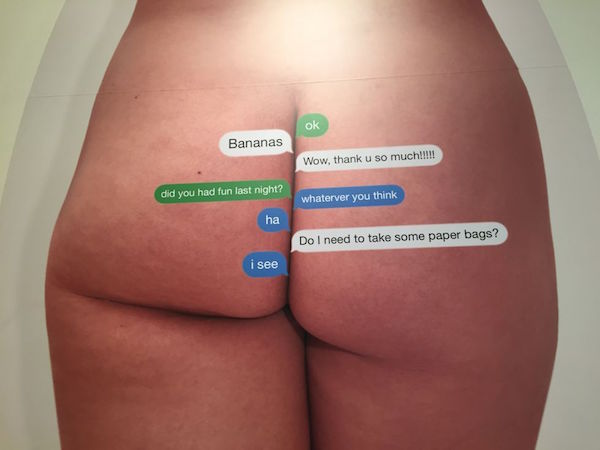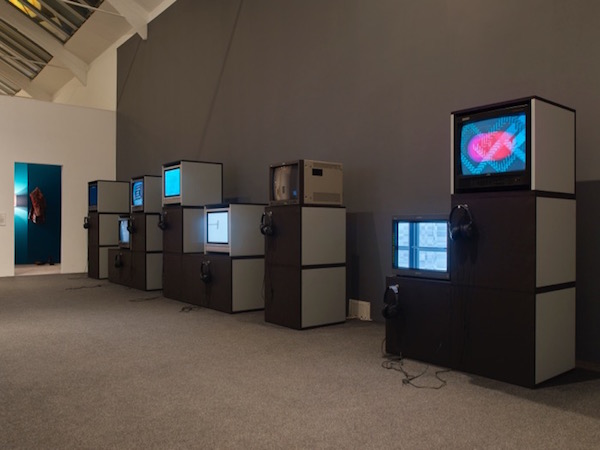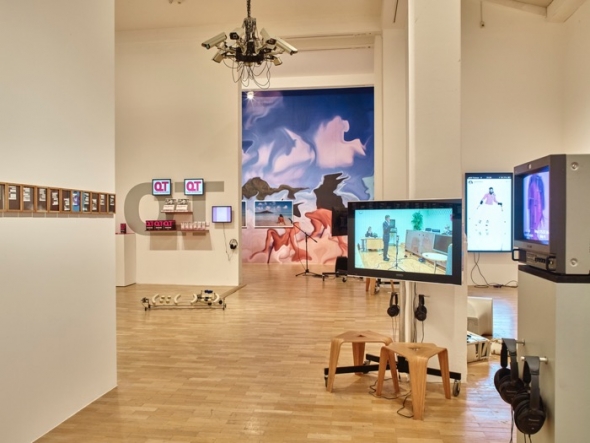Eleven Pro-tips for Art plus Internet
In his review of the Whitechapel Gallery’s Electronic Superhighway (2016 – 1966) exhibition, Matthew Fuller immerses himself fully in the minds of its curators
Electronic Superhighway is an amazing feat of curation. It starts with a slice of the present and drills inexorably back through time from post-internet, to net art, to video art, to computer art, to kinetic art and happenings. This show maximises its conceptual lifting power by illustrating how communications networks all point one way – to our illustrious present. As the show moves back through time with each of these phases, the inverse pyramid of art shown becomes smaller and the rooms get emptier as less work stands in for more art.
Such an exhibition sets the terms for a whole new range of curator-skillz for the coming season – and that needs a decode. To let you in on the thinking behind this operation we overshare the inside on how to line up those ones and zeroes in regular order.
§ Bring on the munge
The range of the work gathered under the phrase Post-internet, or what stands in for the present, is complicated. It might even look as if a decent show could be made of some of such work on its own without the need for a heavy load of underworked claims to being a full survey of a longer period.
Best to see that problem of nomenclature as an opportunity, assimilating a whole consignment of different artists under one key term, and appeasing those that feel left out if they aren’t given the same name as everyone else by slapping it all over them too. Try to maintain the complexity-feeling though. One way to do this is by chucking loads of art in one room to give back that junk-shop vibe to the East End community – who knows what you’re looking at when the works are all on top of each other? This makes it fun! Which is like the internet?
§ Digital art is so over!
The institutional double of contemporary art can claim to have digested digital art and has not changed a bit, so now who’s more meta? Objects, images and videos that bear traces of some computational passage or allusion to such a state can be lined up in a room, so what is it with all these words before ‘art’? Ages ago the art world thought that technology sucked, that it had nothing to do with art. From the 1960s onwards a whole load of artists built up other networks and institutions around digital art, new media art, systems art, electronic art and so on. But that’s history. Now all that doesn’t mean anything because we can just look at the art bit. This is what it all leads up to, right now. Conjunction-art is so over, just like the last thing.

Image: Olaf Breuning, Text Butt, 2015
§ Make art history better by being better than history
If you’ve got a lot of things in a room, put some years at the end of the exhibition title and drag unrelated work in to legitimate it. Historical surveys are important, they set up the means by which people assemble an understanding of how we arrived at the present and show us the ways in which multiple kinds of art making exist contemporaneously. Looking like it might be a historical survey gives gravitas. On the one hand curators have to take an ethical lesson from this: don’t just think the present is all about you – the past is as well. On the other, make sure that the past is just as confusing and full of unmeetable deadlines and emails and tweets that make actual thought impossible in the present.
§ Face it, art looks better against white walls
Whiteness makes walls fall into the background to show the liveliness of colour. Why not extend the effect by making sure that art has the benefits of whiteness too? We all know that artists and artist groups, even argumentative ones, such as Mongrel, Ricardo Dominguez, Coco Fusco, Keith Piper, were key to the development of digital art, it’s sooo known in fact that it’s just tedious to keep repeating it as if art history isn’t always in the making by savvy curators and their managers. Of course any show needs a sprinkle, but let’s keep the emulsion properly rollered.
§ Be random
It’s all about the power of the contingency of the incomputable. If an art scene such as net.art was often described as having a recognised set of genitive members, then drop one or two of the ‘Heroes’ out like a prolapsed Birkin. If you are claiming to run a historical survey, that includes Bunting, Lialina, Jodi, Cosić, show that scholarly accuracy ain’t the boss of you – and drop Shulgin / Bookchin / both. Show the dice of destiny this is how you roll.
§ Don’t make art by committee
Seriously, did any good come of corporate culture? And we are so way beyond that. Art has got to embrace the power of the individual if it is to mean anything, so why show work by groups? The collectives, servers, spaces, BBSs, groups, that provided the platforms for art or that made key works? Meh: smells like politics. Do we have to spell it out for you: art consists of individuals and their gallerists.
§ All Out, Stay Out
And all of those who thought the networks provided a space outside of the gallery-museum circuit where other ways of working could come to the fore and play in and between established spaces for art? You were right baby! It is a space outside, permanently.
§ Simplify Process
Remember, things should be illustrations of things, not actual things. Things should be thinkpieces, not thought inducing. And mostly, things should be objects. Art improves people by its inherent unpredictability. Therefore, if you are planning to make a show purporting to be about art and communications networks, don’t connect much art to the internet – nooob! If a work is made as a website, on a social media platform such as Instagram, or a network process involving the operation of servers, browsers, the connections of users, turn it into a video file. As for hacks, interruptions, hijacks, interaction, performances, transformation, sociotechnical processes? Those all spell attention-doom in an art-minute.

Image: the past is emptier, upstairs at Electronic Superhighway
§ The Internet is stupid – so embrace it
Remember how you just learned that pictures come before programs! If it can be shown that computer artists started with images, what is arrived at now is the same, just better – and way bigger. What comes in the middle was just a dalliance with difficulty. So artists have made search engines, new kinds of devices, databases, wreaked havoc on codecs and standards and claimed that the technological is also inherently cultural and aesthetic and can be worked on as such? Let’s not worry our heads with that, save it for the geeks, or the nerds, or the artists – whatevs. If you have to go in that direction keep it a one-liner, and Keep It Kawaii, preferably museum size XL.
§ Challenge expectations
If an artwork is made in colour, show it on a black and white monitor. Bureau of Inverse Technology, whose work gets this treatment, can hardly complain can they – they’re in the show, and it can always be swapped out later when one of the other machines breaks down. Clumsiness suggests exuberance, enthusiasm, an invitation to the world to join in with an open architecture of becoming.
§ Against the money economy
We live in a world where anything can be more expensive, but nothing can be cheaper. We live in a world so degraded that even the billionaires who quasi-sponsor our shows have to live in replica showhomes that are just like the normal beige off-plan theatre of oppression that art is all about not being – except the walls are just bigger, with a drearily Cartesian consequential effect on the floors and ceilings. In short, there’s something to get mad about when it comes to the economy, so we need to reject its norms. Because another world is possible, think like a tactical trickster of a curation shaman: don’t pay artists for showing their work, but charge people twelve quid to get in to the gallery: it’s LOL vs LMAO!
Matthew Fuller <m.fuller AT gold.ac.uk> teaches on the MA Digital Culture at Goldsmiths, University of London
Info
The Electronic Superhighway (2016-1966) is at the Whitechapel Gallery, London 29 Jan - 15 May 2016
Mute Books Orders
For Mute Books distribution contact Anagram Books
contact@anagrambooks.com
For online purchases visit anagrambooks.com







